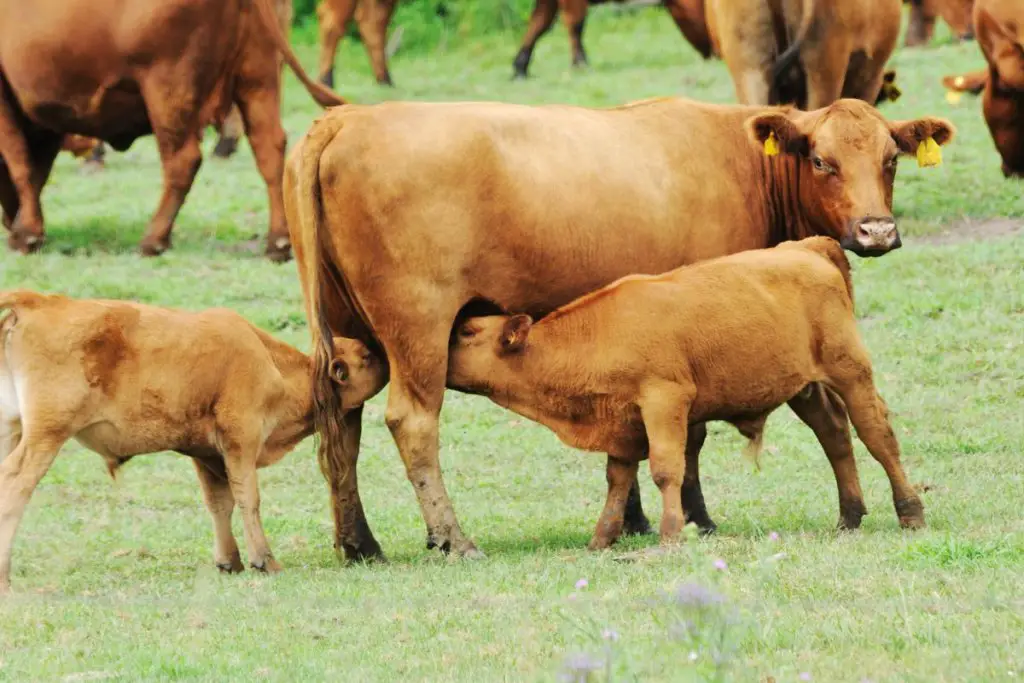A cow can have twins. Twin calving in beef cattle is about 2% and in dairy cattle such as Holstein Fresian, it can be as high as 5%.
Twins in cows result from double ovulation or embryo split. Double ovulation results in fraternal twins while embryo split results in identical twins.
Can A Cow Have Twins?
Twinning in cows happens between 2% and 5% of the time, providing a welcome bonus for their owners. A cow can have twin bulls, twin cows or a heifer calf and a bull calf.

Triplets and quadruplets are even rarer than twins, happening only once in every 100,000 births.
Twin calving in dairy cattle is more common than in beef cattle. There are various factors that can increase the chance of twins, including:
- Age: Older cows have a higher chance of having twins. Mature cows that have calved several times have a high chance of double ovulation than heifers. Twinning is common from the second to third parity. This study shows a twinning rate of 5.8% for multiparous and 1.2% for nulliparous.
- Season: Cows that calve in spring and summer are more likely to have twins than those that calve in autumn or winter. This could be because of high feed intake during the cold season and lack of heat stress which can damage the embryo. The ovulation rates and survival rates of the embryo determine the type of birth – single calf or multiple calves.
- Genetics: Cows that have a family history of twins have a higher chance of having them too. A heifer born from a twin pregnancy is more likely to have twins. The breed (more on this later) also influences the twinning rate.
- Nutrition: Good nutrition increases the rate of multiple births. A quality diet before and during pregnancy increases the chances of double ovulation in dairy cows.
- Milk yield: Cows that increase milk production near ovulation have a high chance of twin births.
- Hormonal influence: Hormonal treatments that are used to prevent pregnancy losses can cause double ovulation.
Common Breeds That Have Twins
Some breeds such as Holstein are more likely to have twins than others. Here are some popular breeds that have twins:
| Breed | Twinning rate |
| Holstein-Friesian | 5% |
| Hereford | 1% |
| Jersey | 1.83% |
| Guernsey | 2.33% |
| Ayrshire | 2.62% |
| Simmental | 2% |
| Angus | 1% |
| Charolais | 2% |
Challenges Of Having Twin Calves
Twinning is undesirable in cow-calf operations because of the challenges it presents. Here are the challenges associated with twin calves:
Reproductive issues: The reproductive performance of cows with multiple births is lower than cows with single calves. Twin births are accompanied by issues such as high incidences of abortions, stillbirths, low birth weight, and mastitis. Cows with twin births need a longer time for uterus regeneration which results in delayed return to estrus.
Dystocia: Dystocia is a difficult or abnormal birth. Dystocia can be caused by fetal malpresentation, oversized calf, and maternal factors such as uterine torsion and hypocalcemia. Incidences of dystocia are more common in twin calves than in singletons. Dystocia leads to stillbirths, metritis, retained placenta, and endometritis.
Freemartinism: When a cow gives birth to a heifer calf and a bull calf the heifer calf is called a freemartin. Freemartins are sterile but they grow well so most ranchers raise them for beef production.
High culling rate: Multiple births cause maternal issues such as infertility and reproductive diseases. These issues force cattle producers to weed out the affected animals.
Shorter gestation length: Cattle have a gestation length of 283 days. The length is shorter in multiple births than in single births at 274 days. This results in a higher mortality rate in calves with lower birth weights and less chance for survival.
Calf abandonment: Natural selection can happen in the animal world. A cow with twin calves may abandon one even if it’s healthy. When calf abandonment happens most cattle producers bottle feed the calf or introduce it to a surrogate.
These challenges have led to the development of strategies to prevent multiple cattle births. Double ovulation is linked to decreased progesterone levels. To avoid twin births, progesterone levels should be increased.
